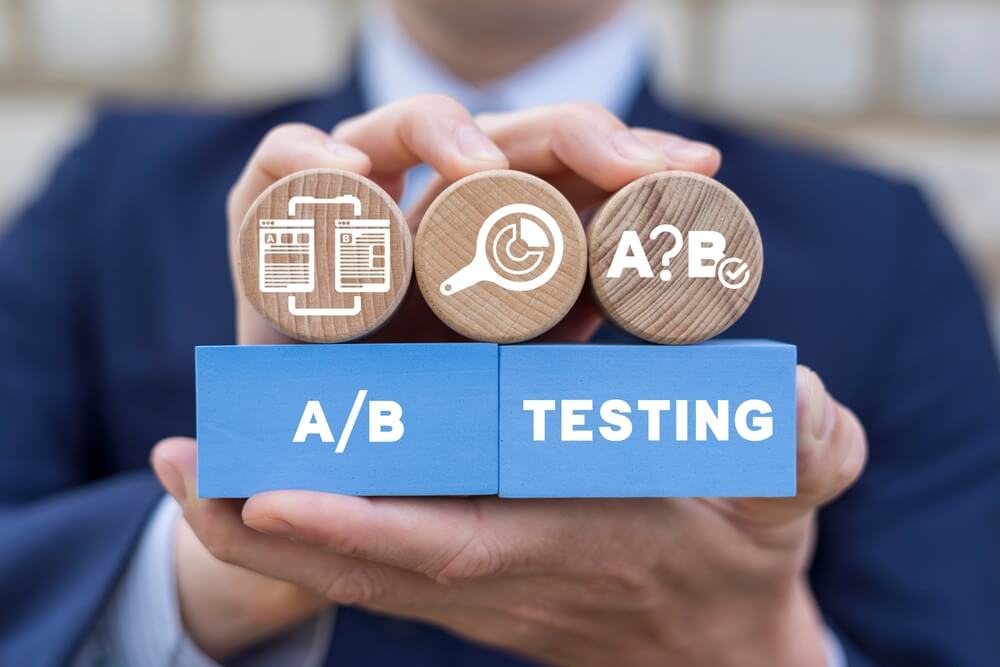
5 Best A/B Testing Methods for B2B Email Optimization
A/B testing is critical in business-to-business (B2B) email marketing, comparing two or more campaign variations to determine which performs better. It helps B2B marketers optimize subject lines, content, or call to action (CTA) buttons, improving engagement, conversion rates, and overall campaign performance.
This guide discusses the best practices for implementing A/B testing in B2B email marketing:
 When creating variations for A/B testing in email marketing, testing one element at a time is essential to accurately assess its impact. This approach allows marketers to isolate the influence of a specific component, be it the subject line, email content, or CTA buttons, ensuring that observed variations in performance are attributed directly to the tested element.
Simultaneously changing multiple elements may muddy the results, making it challenging to pinpoint which adjustment led to the observed differences in engagement or conversion rates. By meticulously altering one variable at a time, marketers gain precise insights into each element’s influence.
Here are strategies that help create meaningful, distinct variations of chosen elements.
When creating variations for A/B testing in email marketing, testing one element at a time is essential to accurately assess its impact. This approach allows marketers to isolate the influence of a specific component, be it the subject line, email content, or CTA buttons, ensuring that observed variations in performance are attributed directly to the tested element.
Simultaneously changing multiple elements may muddy the results, making it challenging to pinpoint which adjustment led to the observed differences in engagement or conversion rates. By meticulously altering one variable at a time, marketers gain precise insights into each element’s influence.
Here are strategies that help create meaningful, distinct variations of chosen elements.
 Audience segmentation enables marketers to assess the effect of variations within relevant and comparable groups. By dividing the audience based on essential characteristics, marketers can tailor A/B tests to specific segments, ensuring meaningful and applicable results.
A targeted approach allows a deeper understanding of how variations resonate within distinct audience subsets, providing insights that could inform personalized strategies. Consider these strategies for segmenting email lists that support effective A/B testing:
Audience segmentation enables marketers to assess the effect of variations within relevant and comparable groups. By dividing the audience based on essential characteristics, marketers can tailor A/B tests to specific segments, ensuring meaningful and applicable results.
A targeted approach allows a deeper understanding of how variations resonate within distinct audience subsets, providing insights that could inform personalized strategies. Consider these strategies for segmenting email lists that support effective A/B testing:
 A thorough analysis of A/B test results extracts meaningful insights and informs decisions in B2B email marketing. Beyond merely comparing performance metrics, a detailed examination allows marketers to understand the nuances of audience behavior and preferences.
Analyzing results helps identify patterns, uncover trends, and reveal correlations between variations and key performance indicators (KPIs). Here are tips for interpreting data and understanding the statistical significance of test outcomes:
A thorough analysis of A/B test results extracts meaningful insights and informs decisions in B2B email marketing. Beyond merely comparing performance metrics, a detailed examination allows marketers to understand the nuances of audience behavior and preferences.
Analyzing results helps identify patterns, uncover trends, and reveal correlations between variations and key performance indicators (KPIs). Here are tips for interpreting data and understanding the statistical significance of test outcomes:
- Choosing the right elements to test.
- Creating variations for testing.
- Segmenting the audience for effective testing.
- Setting clear goals and metrics.
- Analyzing test results for insights.
Tired of investing in Search Engine Optimization without getting any results? See how Digital Authority Partners turns that around!
1. Choosing the Right Elements to Test
Selecting the appropriate elements for A/B testing influences campaign effectiveness. Subject lines impact open rates. Email content affects engagement, while CTA buttons influence conversion rates. Additionally, testing the timing of email delivery helps determine when the audience is most responsive. By strategically choosing these elements, marketers can gain valuable insights into their audience’s preferences and behavior, allowing them to make informed decisions that enhance overall campaign performance. A marketing email has several elements. Here is how to identify which elements affect campaign performance the most:- Understand the B2B audience and segment them based on characteristics such as industry, job role, or previous interactions.
- Analyze past campaign data to identify patterns or trends. Examine which elements correlated with higher engagement or conversion rates in previous campaigns.
- Stay informed about industry benchmarks and best practices. Elements aligned with established benchmarks, such as optimal email open or click-through rates (CTRs), can be prioritized for testing.
- Solicit feedback from the B2B audience through surveys or direct communication.
- Examine the email marketing strategies of competitors. Identify which elements resonate with their audience and consider testing similar aspects within campaigns.
2. Creating Variations for Testing
 When creating variations for A/B testing in email marketing, testing one element at a time is essential to accurately assess its impact. This approach allows marketers to isolate the influence of a specific component, be it the subject line, email content, or CTA buttons, ensuring that observed variations in performance are attributed directly to the tested element.
Simultaneously changing multiple elements may muddy the results, making it challenging to pinpoint which adjustment led to the observed differences in engagement or conversion rates. By meticulously altering one variable at a time, marketers gain precise insights into each element’s influence.
Here are strategies that help create meaningful, distinct variations of chosen elements.
When creating variations for A/B testing in email marketing, testing one element at a time is essential to accurately assess its impact. This approach allows marketers to isolate the influence of a specific component, be it the subject line, email content, or CTA buttons, ensuring that observed variations in performance are attributed directly to the tested element.
Simultaneously changing multiple elements may muddy the results, making it challenging to pinpoint which adjustment led to the observed differences in engagement or conversion rates. By meticulously altering one variable at a time, marketers gain precise insights into each element’s influence.
Here are strategies that help create meaningful, distinct variations of chosen elements.
a. Headline Tone and Length
When testing email subject lines, create variations in tone (e.g., formal vs. casual) and length. Experiment with concise versus longer subject lines to gauge how these variations affect open rates and recipient engagement.b. Content Structure and Messaging
Vary the structure and messaging style of email content. Test different content lengths, visual assets, and placement of crucial information. Assess which variations resonate best with the B2B audience and contribute to increased CTR.c. CTA Button Design and Placement
When testing CTA buttons, experiment with different designs, colors, and placements within the email. Assess whether a more prominent or subtly integrated CTA button leads to increased conversions and tailor the strategy as appropriate.d. Personalization Levels
Explore the effect of personalization by adjusting the extent to which recipient details are incorporated. Test personalized subject lines, salutations, or content sections to understand the optimal level of personalization that resonates with the audience without seeming intrusive.e. Sending Times and Frequencies
For testing the timing of email delivery, vary the day of the week and time of day. Additionally, experiment with different email frequencies to determine the optimal rate of occurrence for engagement without overwhelming the audience.f. Visual Elements and Branding
Test variations in visual elements and branding. Assess how changes in email layout, font styles, or overall design influence the perception of the brand and the engagement levels of the B2B audience. Consistent and recognizable branding elements can contribute to a cohesive and impactful email strategy. Consider hiring a B2B content marketing expert to create effective email content and messaging that resonates with the audience. Doing so increases conversions and contributes to long-term revenue.3. Segmenting the Audience for Effective Testing
 Audience segmentation enables marketers to assess the effect of variations within relevant and comparable groups. By dividing the audience based on essential characteristics, marketers can tailor A/B tests to specific segments, ensuring meaningful and applicable results.
A targeted approach allows a deeper understanding of how variations resonate within distinct audience subsets, providing insights that could inform personalized strategies. Consider these strategies for segmenting email lists that support effective A/B testing:
Audience segmentation enables marketers to assess the effect of variations within relevant and comparable groups. By dividing the audience based on essential characteristics, marketers can tailor A/B tests to specific segments, ensuring meaningful and applicable results.
A targeted approach allows a deeper understanding of how variations resonate within distinct audience subsets, providing insights that could inform personalized strategies. Consider these strategies for segmenting email lists that support effective A/B testing:
- Segment the email list based on demographic factors such as industry, job role, company size, or geographic location.
- Divide the audience based on their historical interactions with emails, such as frequent openers versus occasional openers.
- Group recipients based on where they are in the sales funnel or their purchase history.
- Analyze user behavior such as website visits, link clicks, or content downloads and use this information to segment the audience.
- Gather information on subscriber preferences and interests through surveys or preference centers.
4. Setting Clear Goals and Metrics
Setting clear objectives creates a roadmap for measuring success and guiding decision-making. Marketers clarify desired outcomes by defining specific goals for each test such as increasing open rates, CTRs, or conversions. This precision streamlines the testing process and ensures that the insights obtained align directly with broader campaign objectives. Clear goals and metrics enable marketers to accurately evaluate the effects of variations and make informed decisions to optimize and enhance B2B email campaigns. These metrics evaluate the success of each variation against marketing objectives:- Open Rates: Measure the percentage of recipients who open emails. A higher open rate suggests that the subject line and email presentation resonate with the audience.
- CTR: Evaluate the percentage of recipients clicking links within the email. A higher CTR indicates that the content and CTA are compelling, driving engagement and encouraging further interaction.
- Conversion Rates: Assess the percentage of recipients who take a desired action such as filling out a form, downloading content, or purchasing. Conversion rates provide insights into the effectiveness of the email in driving meaningful outcomes.
- Bounce Rates: Monitor the percentage of emails not delivered due to invalid addresses or other issues. Low bounce rates indicate a clean and accurate email list, contributing to overall deliverability.
- Revenue Generated: Tie email campaign success to revenue by tracking sales or business generated due to each variation. This metric provides a direct link between email performance and tangible business outcomes.
- Engagement Metrics Beyond Clicks: Consider additional engagement metrics, such as time spent on the landing page, or the number of pages viewed. These metrics offer a more nuanced understanding of how recipients interact with the content beyond initial clicks.
5. Analyzing Test Results for Insights
 A thorough analysis of A/B test results extracts meaningful insights and informs decisions in B2B email marketing. Beyond merely comparing performance metrics, a detailed examination allows marketers to understand the nuances of audience behavior and preferences.
Analyzing results helps identify patterns, uncover trends, and reveal correlations between variations and key performance indicators (KPIs). Here are tips for interpreting data and understanding the statistical significance of test outcomes:
A thorough analysis of A/B test results extracts meaningful insights and informs decisions in B2B email marketing. Beyond merely comparing performance metrics, a detailed examination allows marketers to understand the nuances of audience behavior and preferences.
Analyzing results helps identify patterns, uncover trends, and reveal correlations between variations and key performance indicators (KPIs). Here are tips for interpreting data and understanding the statistical significance of test outcomes:
- Ensure that the sample size is statistically significant to draw valid conclusions. A larger sample size reduces the error margin and increases the results’ reliability.
- Use statistical calculators to determine the required sample size based on confidence level and desired statistical power.
- Employ statistical significance tests, such as chi-square tests for categorical data or t-tests for continuous data, to assess whether the observed differences between variations are due to chance.
- Use confidence intervals to establish a range within which the true population parameter will likely fall. A narrow confidence interval suggests more precise estimates, offering greater confidence in the observed effects.
- Avoid overlooking subtle trends and patterns in the data. Sometimes, even if a result is not statistically significant, it may offer valuable insights.
- Consider the practical significance of the observed effects. Evaluate whether the differences between variations, while statistically significant, are also meaningful in the context of campaign objectives.
Summing Up
Best practices for A/B testing in B2B email marketing involve selecting elements such as subject lines, content, or CTAs, setting clear objectives, and thoroughly analyzing results. Marketers can refine strategies for better engagement and conversions by following the strategies above. A/B testing is essential in ongoing campaign optimization, allowing B2B marketers to stay responsive to evolving audience preferences. Embracing A/B testing as a regular practice fine-tunes email strategies, fostering continuous improvement and ultimately leading to more effective and impactful B2B email campaigns. How can A/B testing be integrated into your regular email marketing routine to consistently enhance performance? Let the experts handle your B2B email campaigns and secure the best results. Contact Digital Authority Partners (DAP) today for the best B2B marketing services.Want To Meet Our Expert Team?
Book a meeting directly here



